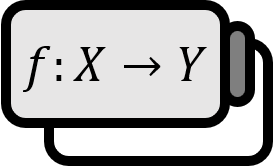Definition of Logarithmic Functions
Definition
The inverse function of the exponential function is defined as the logarithmic function $\log : (0,\infty) \to \mathbb{R}$. If for all $x \in (0,\infty)$, $x = e^y$ holds, then the logarithmic function is expressed as follows: $$ \log x := y $$
Explanation
Despite its simple definition, logarithms hold significant meaning across mathematics. The base can be any positive number, but it is typically set as Euler’s constant $e$ as per the definition above. In the curriculum and engineering, to distinguish from the common logarithm with base $10$, it is represented as the natural logarithm $\ln$. However, closer to natural sciences, it is written without distinction as $\log$.
Number Theory
In analytic number theory, logarithms themselves form a series of the Mangoldt function and appear formally when defining the differentiation of arithmetic functions.
Information Theory
In computer science or information theory, the unit bit is frequently used, therefore making the base of logarithms mostly $2$, and unlike natural science literature, it is naturally assumed to use $\log = \log_{2}$. In particular, in information theory, it is identified as a function that satisfies various conditions that the concept of ‘information’ must meet.
Extension to Complex Functions 1
Build-up
Let’s refer to the historical background of the exponential function as the logarithm $\log_{\mathbb{C}} : \mathbb{C} \setminus \left\{ 0 \right\} \to \mathbb{C}$. If for all $z \in \mathbb{C} \setminus \left\{ 0 \right\}$, $z = e^w$ holds, then the logarithm $\log_{\mathbb{C}}$, when compared with the real-defined logarithm $\log_{\mathbb{R}}$, can be expressed as follows: $$ \log_{\mathbb{C}} z := w(z) $$ However, considering the argument $\arg z = \theta$ of $z = r e^{i \theta}$, it corresponds to infinitely many values, thus not strictly being a function. Expressing it in polar coordinates for $w := u + iv$, we have: $$ z = e^{w} \implies r \left( \cos \theta + i \sin \theta \right) = e^{u} \left( \cos v + i \sin v \right) $$ Considering the real part and the imaginary part separately, it results in: $$ r = e^{u} \\ \sin \theta = \sin v $$ Hence for $k \in \mathbb{Z}$, $$ u = \log_{\mathbb{R}} r \\ v = \theta + 2 k \pi $$ Summing up, $$ \log_{\mathbb{C}} z = \log_{\mathbb{R}} |z| + i \left( \arg z + 2 k \pi \right) $$ As previously mentioned, $\log_{\mathbb{C}}$ has as many values as $k \in \mathbb{Z}$, making it not a function. According to $k$, subsets of $\mathbb{C} \setminus \left\{ 0 \right\}$ that appear every time it makes a full turn are called branches of the logarithm. Particularly, we call the case when $k=0$ the principal branch, and we redefine the logarithmic function $\text{Log}$ using the uppercase $L$ as follows.
Extension
The expression $\text{Log} : \mathbb{C} \setminus \left\{ 0 \right\} \to \mathbb{C}$ is defined as: $$ \text{Log} z := \log_{\mathbb{R}} |z| + i \arg z $$
Properties
The following holds by definition: $$ \log(xy) = \log x + \log y,\qquad \log\left(\dfrac{x}{y}\right) = \log x - \log y $$ $$ \log(x^{n}) = n \log x $$
Since $(\log x)^{\prime \prime} = -\dfrac{1}{x^{2}}$, it is a concave function.
The following inequality holds.
$$ 1 - \dfrac{1}{x} \le \ln x \le x - 1\qquad \text{ for } x \gt 0 $$
Osborne (1999). Complex variables and their applications: p31. ↩︎
